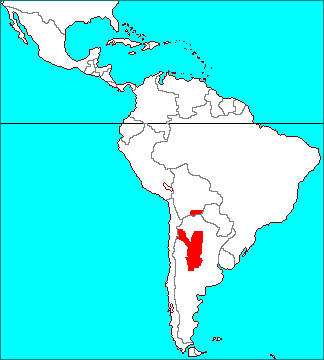
Bolivia, Argentina
Bolivia (Tarija),
Argentina (Catamarca, Santiago del Estero, Córdoba, San Luis)
500 m elevation
Epiphytic
Tillandsia rectangula
Tillandsia (Diaphoranthema) rectangula Baker (1878)
- [ Etymology ] rectus + angularis in Latin (linear + angular)
- It resembles Tillandsia funebris. Leaves of Tillandsia rectangla are up to 20 mm and shorter than those of Tillandsia funebris. The stem is longer than leaves. Floral bracts are shorter and as half as sepals.
- [ Width ] 35 - 40 mm
- [ Height ] 40 mm, Flowering 40 - 50 mm
- [ Stem ] D 5 cm
- [ Petal ] Yellow C10 M30 Y80 K30
- [ Bract ] Greenish brown C40 M40 Y100 K0
- [ Flower ] June - July
- [ Flower ] for 6 days
- [ Cultivar ]
- Brown flower
Classification
- [ Genus ] Tillandsia
- [ Subgenus ] Diaphoranthema
- [ Group ] rectangula
- [ Species ] rectangula
- [ Synonyms ]
- Tillandsia propingqua var. rectangula Grisebach
Cultivation
Informations summarized here are based on our experiences, and TrekGEO does not guarantee the results by cultivating in the same or similar conditions described here. Even a species of Tillandsia differs substantially between individuals, and is very sensitive in changes of environments. Applicatons of any idea inspired by this site should be at your own risks.
3rd Plant
- Cultivation condition
- Partial sun, Dipping, Shelving, AC / Heater
- Jun 2025 It flowered.
- Jun 2025 An inflorescence began to grow.
- Aug 2024 An offset began to grow from the bottom of the inflorescence.
- Jul 2024 It flowered.
- Jun 2024 An inflorescence began to grow.
- Nov 2023 A root began to grow.
- Sep 2022 It keeps growing.
- May 2021 Good condition.
2nd Plant (HR5239)
- Cultivation condition
- Partial sun, Dipping, Shelving, AC / Heater
- Sep 2025 It keeps growing.
- May 2024 Roots began to grow.
- May 2021 Good condition.
1st Plant
- Cultivation condition
- Partial shade, Long soaking, Shelving, Indoors
- Mar 2009 It keeps growing.
- Jul 2007 The growing point does not die in this cultivation circumstance.
- Oct 2006 Moved to another site. Cultivation condition is almost same as the previous site.
- Oct 2005 The growing point died and 2 offsets began to grow.
- Aug 2004 The temperature rises above 30 degree C for 40 days, and the highest temperature was over 39 degree C.
- The growing point dies occasionally and offsets grow repeatedly.